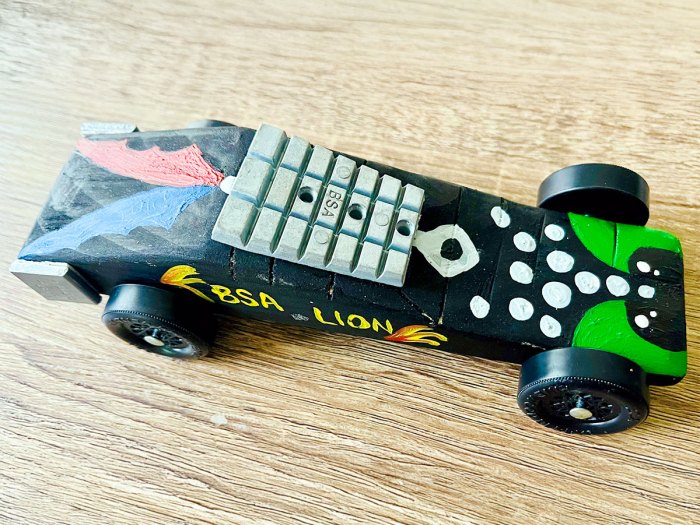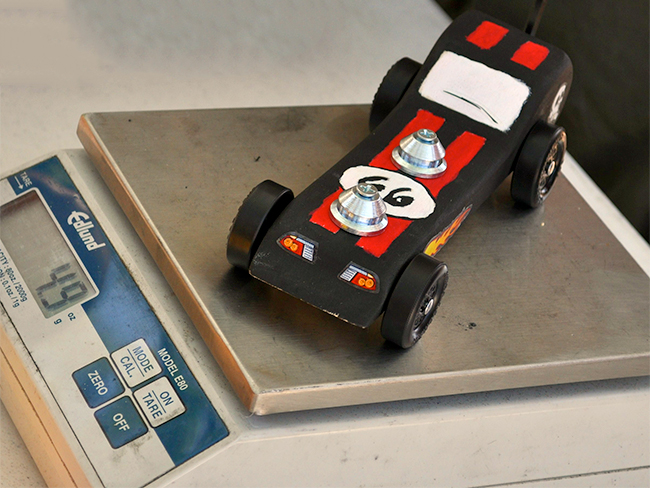Where Do I Put Weights on a Pinewood Derby Car To Make It Go Faster?

There are some questions that have plagued mankind since the beginning of recorded history:
- Why are we here?
- What’s the ultimate answer to the ultimate question of life, the universe and everything?
- Where do I put weights on my Pinewood Derby car?
While we can’t help you with the first two, here’s what we know about placing weights on a Pinewood Derby car.

MAX OUT YOUR CAR’S WEIGHT AT 5 OZ
First, the basics: Your car should weigh as much as it’s allowed. In most races, a Pinewood Derby car’s weight is limited to 5 ounces. If your car weighs less than that, add coins or other weights.
As far as where you should put those weights on your car … well, let’s just say opinions differ.
PUT MOST OF THE WEIGHT IN THE BACK OF THE PINEWOOD DERBY CAR
Science says the heaviest part of your car should be about 1 inch in front of the rear axle. The idea is that the farther back the weight is, the more potential energy you have because your center of mass is higher up on the track. (Don’t put it too far back, or your Pinewood Derby car will become unstable and pop a wheelie.)
Our expert says if you do this correctly, you will beat a Pinewood Derby car built exactly the same — except with the weight toward its front — by 4.6 car lengths.
That’s a lot of car lengths.
And you can’t argue with science, right?
PUT MOST OF THE WEIGHT IN THE FRONT OF THE PINEWOOD DERBY CAR
Well, we’ve heard from multiple field testers who claim that they’ve finished near the top of multiple Pinewood Derby races by putting the majority of their weight near the front of the car.
The idea here is that placing the weight near the front of the car gives it the tiniest bit of “head start” over a car with its weight near the rear. Or, perhaps attaching the weight to the front of the car — in these cases, at least — forces the car to ride smoother down the track.
So where should you put weights on a Pinewood Derby car? The ultimate answer is: It depends on who you ask. Our advice: Put your weight wherever you want, and spend most of your time polishing your car’s axles. That’s a great way to reduce drag and increase your speed.
Good luck!
Get rid of the wood. Your car should resemble a Hershey bar. Use tungsten for weight. Set Center of Mass 3/4″ in front of rear axle slot. Polish wheel bores. Do not get overly concerned about the axles. The axles do not turn.
RAILRIDE !
If every car has identical weight, wheels, axles, alignment then the resulting winner is the one that has maximized the available potential energy. The one variable in the car design is its center of gravity which is the only factor used to calculate the potential energy. The math gets fun when you start to factor in a 30 degree assumed ramp angle. Basically You gain more energy the higher you cg is placed in the car, not just keeping it at the “ideal” one inch ahead of the rear wheel. Overdue due it on the super high weight position and you battle with lost stability, friction braking. Testing over multiple builds is the art in finding balance between high rear weight position and a counter balancing low front weight position to keep you pointed down the track.
Smart. Smart indeed.
weight in the back… all day
I evenly distributed the weight between the axels and we dominated and are going to district!
I don’t bother with a PWD car.
Yes. The answer to the universe is 42.
Then why post a reply on a PWD web page?
Right?! 🙄
Answer to the second question about life, the universe, and everything is 42.
Perhaps you don’t understand what the question really is.
Please do not put your weight in the front. A car with weight in the rear will ALWAYS beat a car weighted in the front!
The question is, What’s the question?
Interesting that it makes a difference since the acceleration due to gravity is constant regardless of how much weight or mass. Seems a heavier car would be more friction on the axles?
The shape of the track also has an effect. Some tracks have a steep hill and a long flat. Others have a more gradual slope and a shorter or no flat.
My track at home proves that weight at the front slows the car down by .2 of a second